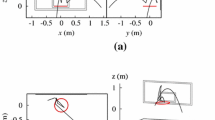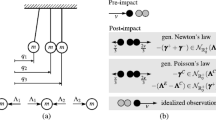Abstract
A common problem in sports mechanics is to understand and to model the impact of a sports ball with some other object such as a sports surface or an implement used to strike the ball. In this review, we focus on a simple collision model that effectively reduces the problem to a collision between two point masses. The mass of the striking implement is replaced by its effective mass, the latter quantity depending primarily on the “swing weight” of the implement and the location of the impact point. For normal or perpendicular impacts, energy loss can be described in terms of the normal coefficient of restitution, e y , or an equivalent “bounce factor”, q. For oblique impacts, the outgoing speed and spin of the ball also depends on the tangential coefficient of restitution, e x . Examples from baseball, tennis and other sports are highlighted.

















Similar content being viewed by others
References
Introductory books and papers
Daish CB (1972) The physics of ball games. The English Universities Press Ltd., London
Brody H (1987) Tennis science for tennis players. University of Pennsylvania Press, Philadelphia
Brody H, Cross R, Lindsey C (2002) The physics and technology of tennis. Racquet Tech Publishing, Solana Beach
Cross R, Lindsey C (2004) Technical tennis: racquets, strings, balls, courts, spin, and bounce. Racquet Tech Publishing, Vista
Brody H (1979) Physics of the tennis racquet. Am J Phys 47:482–487
Brody H (1995) How would a physicist design a tennis racket? Phys Today 48:26–31
Kotze J, Mitchell, SR, Rothberg, SJ (2000) The role of the racket in high speed tennis serves. Sports Eng 3(2):67–84
Adair RK (2002) The physics of baseball, 3rd edn. Perennial/Harper Collins, New York
Frohlich C (2011) Resource letter PS-2: physics of sports. Am J Phys 79:565–574
Cross R (2011) Physics of baseball and softball. Springer, New York
Cross R (1999) The bounce of a ball. Am J Phys 67(3):222–227
Cross R (2008) Differences between bouncing balls, springs and rods. Am J Phys 76(10):908–915
Ball properties
Cross R (1999) Dynamic properties of tennis balls. Sports Eng 2(1):23–34
Goodwill S, Kirk R, Haake S (2005) Experimental and finite element analysis of a tennis ball impact on a rigid surface. Sports Eng 8:145–158
Hubbard M, Stronge, W (2001) Bounce of hollow balls on flat surfaces. Sports Eng 4:49–61
Stronge W, Ashcroft A (2007) Oblique impact of inflated balls at large deflections. Int J Impact Eng 34:1003–1019
Rezaei A, Verhelst R, Paepegem W, Degrieck J (2011) Finite element modelling and experimental study of oblique soccer ball bounce. J Sports Sci 29(11):1201–1213
Karagiozova D, Zhang X, Yu T (2012) Static and dynamic snap-through behaviour of an elastic spherical shell. Acta Mech Sin 28(3):695–710
Jones I (2002) Is the impact of a golf ball Hertzian? In: Ed Thain E (ed) Science and Golf 4, Routledge, London, vol 44, pp 501–513
Carre M, James D, Haake S (2004) Impact of a non-homogeneous sphere on a rigid surface. J Mech Eng Sci 218(3):273–281
Fuss F (2008) Cricket balls: construction, non-linear viscoelastic properties, quality control and implications for the game. Sports Technol 1(1):41–55
Smith L, Nathan A, Duris J (2010) A determination of the dynamic response of softballs. Sports Eng 12(4):163–169
Burbank S, Smith L (2012) Dynamic characterization of rigid polyurethane foam used in sports balls. J Sports Eng Technol 226:77–85
Collins F, Brabazon D, Moran K (2011) Viscoelastic impact characterisation of solid sports balls used in the Irish sport of Hurling. Sports Eng 14(1):15–25. Also in Procedia Engineering 2 (2010) 2991–2997
Hendee S, Greenwald R, Crisco J (1998) Static and dynamic properties of various baseballs. JAppl Biomech 14:390–400
Ball models
Gugan D (2000) Inelastic collision and the Hertz theory of impact. Am J Phys 68(10):920–924
Dintwa E, Tijskens E, Ramon H (2008) On the accuracy of the Hertz model to describe the normal contact of soft elastic spheres. Granular Matter 10:209–221
Strangwood M, Johnson A, Otto S (2006) Energy losses in viscoelastic golf balls. Proc IEEE Mech Eng Part L J Mater 220(1):23–30
Ranga D, Strangwood M (2010) Finite element modelling of the quasi-static and dynamic behaviour of a solid sports ball based on component material properties. Procedia Eng 2:3287–3292
Smith L, Duris J (2009) Progress and challenges in numerically modeling solid sports balls with applications to softballs. J Sports Sci 27(4):353–360
Yigit A, Christoforou A, Majeed A (2011) A nonlinear visco-elastoplastic impact model and the coefficient of restitution. Nonlinear Dyn 66:509–521
Coefficient of restitution, Sweet spot, Dead spot
Tait PG, Steele WJ (1865) A treatise on the dynamics of a particle, 2nd edn. Macmillan, London
Barnes G (1958) Study of collisions. Part. I. A Survey of the Periodical Literature. Am J Phys 26(1):5–8
Barnes G (1958) Study of collisions. Part II. Survey of the textbooks. Am J Phys 26(1):9–12
Cross R (1999) Impact of a ball with a bat or racket. Am J Phys 67(8):692–702
Nathan A (2000) Dynamics of the baseball bat collision. Am J Phys 68(11):979–990
Cross R (2003) Flexible beam analysis of the effects of string tension and frame stiffness on racket performance. Sports Eng 3:111–122
Cross R (1998) The sweet spot of a baseball bat. Am J Phys 66(9):772–779
Cross R (1998) The sweet spots of a tennis racquet. Sports Eng 1(2):63–78
Cross R (2000) The coefficient of restitution for collisions of happy balls, unhappy balls, and tennis balls. Am J Phys 68(11):1025–1031
Nathan A, Russell D, Smith L (2004) The physics of the trampoline effect in baseball and softball bats. In: Proceedings of 5th international conference on engineering of sport, vol 2, UC Davis, pp 38–44
Nathan A (2003) Characterizing the performance of baseball bats. Am J Phys 71(2):134–143
Cross R (1998) The dead spot of a tennis racket. Am J Phys 65(8):754–764
Measurements of q
Smith L (2001) Evaluating baseball bat performance. Sports Eng 4:205–214
Smith L (2008) Progress in measuring the performance of baseball and softball bats. Sports Technol 1:291–299
Cross R, Nathan A (2009) Performance vs moment of inertia of sporting implements. Sports Technol 2(1–2):7–15
Swing speed vs swing weight
Smith L, Broker J, Nathan A (2003) A study of softball player swing speed. In: Subic A, Trivailo P, Alam F (eds) Sports dynamics discovery and application, Melbourne, Australia, pp 12–17
Smith L, Kensrud J (2013) Field and laboratory measurements of softball player swing speed and bat performance. Sports Eng. doi:10.1007/s12283-013-0126-y
Cross R, Bower R (2006) Effects of swing-weight on swing speed and racket power. J Sports Sci 24(1):23–30
Schorah D, Choppin S, James D (2012) Investigating the relationship between swing weight and swing speed across different sports using historical data. Procedia Eng 34:766–771
Performance studies
Nathan A, Smith L, Faber W (2011) Reducing the effect of the ball on bat performance measurements. Sports Technol 4(1–2):13–18
Nathan A, Crisco J, Greenwald R, Russell D, Smith L (2011) A comparative study of baseball bat performance. Sports Eng 13(4):153–162
Alsakarneh A, Bryan K, Cotterell M, Barrett J (2012) The influence of equipment variations on sliotar-hurley impact in the Irish game of hurling. Sports Eng 15(4):177–188
Allen T, Foster L, Carre M, Choppin S (2012) Characterising the impact performance of field hockey sticks. Sports Eng 15(4):221–226
Brooks R, Mather JS, Knowles S (2006) The influence of impact vibration modes and frequencies on cricket bat performance. Proc IMechE Part L J Materi Des Appl 220:237–248
Bower R (2012) The sweet spot of a cricket bat for low speed impacts. Sports Eng 15(2):53–60
Smith L, Singh H (2008) An examination of cricket bat performance. In: Proceedings of 7th ISEA conference, Biarritz. pp 475–482
Cross R (2004) Center of percussion of hand-held implements. Am J Phys 72(5):622–630
Oblique bounce
Cross R (2002) Grip-slip behaviour of a bouncing ball. Am J Phys 70(11):1093–1102
Cross R (2005) Bounce of a spinning ball near normal incidence. Am J Phys 73(10): 914–920
Cross R (2010) Impact of a ball on a surface with tangential compliance. Am J Phys 78(7):716–720
Cross R (2010) Enhancing the bounce of a ball. The Phys Teacher 48(10):450–452
Cross R, Nathan A (2006) Scattering of a baseball by a bat. Am J Phys 74(10):896–904
Sawicki G, Hubbard M, Stronge W (2003) How to hit home runs: optimum baseball swing parameters for maximum range trajectories. Am J Phys 71:1152–1162
Spin off tennis strings
Cross R, Lindsey C (2010) Which strings generate the most spin? Tennis Warehouse. http://twu.tennis-warehouse.com/learning_center/spinexperiment.php
Haake SJ, Allen TB, Jones A, Spurr J, Goodwill S (2012) Effect of inter-string friction on tennis ball rebound. Proc Inst Mech Eng J J Eng Tribol 226:626–635
Kawazoe Y, Okimoto K (2005) Super high speed video analysis of tennis top spin and its performance improvement by string lubrication. In: Subic A, Ujihashi S (eds) The impact of technology on sport. ASTA Publishing, Stockbridge, pp 379–385
Kawazoe Y, Okimoto, K (2008) Tennis top spin comparison between new, used and lubricated used strings by high speed video analysis with impact simulation. Theor Appl Mech Japan 57:511–522
Kawazoe Y, Okimoto K, Okimoto K (2012) Mechanism of tennis racket spin performance. J Syst Des Dyn 6(2):200–212
Lindsey C (2010) Spin and String Pattern. Tennis Warehouse. http://twu.tennis-warehouse.com/learning_center/stringpattern.php
Cross R, Lindsey C (2013) Spin and String Patterns Old, New, and Illegal. Tennis Warehouse. http://twu.tennis-warehouse.com/learning_center/spinpatterns.php
Nicolaides et al. (2013) Effect of string bed pattern on ball spin generation from a tennis racket, Sports Eng
Allen T, Haake S, Goodwill S (2011) Effect of tennis racket parameters on a simulated groundstroke. J Sports Sci 29(3):311–325
Author information
Authors and Affiliations
Corresponding author
Rights and permissions
About this article
Cite this article
Cross, R. Impact of sports balls with striking implements. Sports Eng 17, 3–22 (2014). https://doi.org/10.1007/s12283-013-0132-0
Published:
Issue Date:
DOI: https://doi.org/10.1007/s12283-013-0132-0




